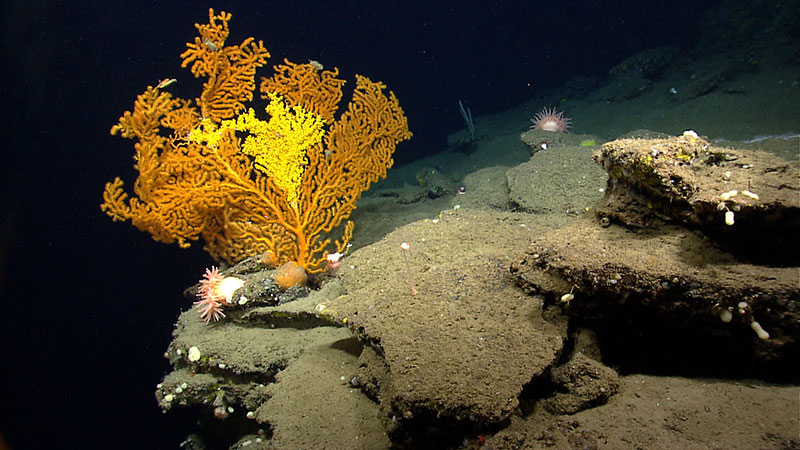
A Paramuricea coral in Nygren Canyon which 165 nautical miles southeast of Cape Cod, Massachusetts. Image courtesy of the NOAA Office of Ocean Exploration and Research, Northeast U.S. Canyons Expedition 2013. Download larger version (jpg, 1.4 MB).

A Paramuricea coral in Nygren Canyon which 165 nautical miles southeast of Cape Cod, Massachusetts. Image courtesy of the NOAA Office of Ocean Exploration and Research, Northeast U.S. Canyons Expedition 2013. Download larger version (jpg, 1.4 MB).
Dive # 8 was on a shallow section along the northeastern flank of Nygren Canyon. The remotely operated vehicle (ROV) was on the bottom at 1526 UTC at 910 meters. The dive track transited over soft sediment with large boulders to a steeply sloped terrain, with rocks that were heavily encrusted and layered with sediment. Various fauna populated the dramatic rock features throughout the dive. The edges of large rock ledges were colonized by high abundances of solitary corals, sponges, brisingid sea stars, and colonial scleractinians. Later in the dive, the following corals were observed: Acanella, Paramuricea, Jasonisis and Paragorgia on ledges or small sedimented patches. In some areas, there were large surfaces of the rocks encrusted with stoloniferous corals. At least 12 additional species of corals were documented, including four types of stoloniferans (Clavularia, white, pink, and yellow type), unknown bamboo, cup corals (at least two species), Solenosmilia, Lophelia pertusa, Parantipathes?, Anthomastus, and Anthothela. There were several examples of one coral colonizing another, including Anthothela on Paramuricea and Anthothela on Paragorgia. As with the previous canyon dives, sea stars were diverse and included Chondraster, Tremaster, brisingids, and a yellow sea star. Squat lobsters appeared more abundant on sediment than corals, with a few individuals observed on Jasonisis that differed from the sediment associates. Red crabs were relatively abundant and two red crabs were noted eating a pyrosome (tunicate-colonial, free floating). There seemed to be a higher diversity of shrimp, with multiple species observed on individual coral colonies. A high diversity of fish fauna was noted throughout the dive and included black dogfish, Antimora, synaphobranchid eels, rattails, Psychrolutidae (fathead), Sebastes, Helicolenus, Hoplostethus, Coryphaenoides, Symphurus, and Hydrolagus. A few highlights from the dive included a large parasitic isopod attached to Hoplostethus, which seemed to interfere with the fish’s ability to swim. Also, a Sebastes was observed eating another fish, with the tail sticking out of its mouth. Several shark egg cases were found attached to Paramuricea throughout the dive, which was the first time during this leg that these had been noted. Overall, very few cephalopods were observed, including a bobtail squid, an unknown squid (possible Illex or Gonatus), and an octopus (Graneledone verrucosa). As we transited up slope, the rock wall appeared to be composed of sandstone, with patches of dark, manganese-coated surfaces. As with our previous canyon dives, we found trash along the dive track, including plastic, traps, and coiled cord. The dive ended over soft sediments where burrows, red crabs, and a variety of fishes were observed. The ROV was off bottom at 661 meters at 2240 UTC.